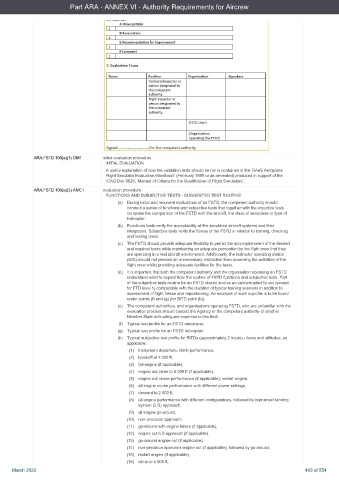Page 463 - UK AirCrew Regulations (Consolidated) March 2022
P. 463
Part ARA - ANNEX VI - Authority Requirements for Aircrew
ARA.FSTD.100(a)(1) GM1 Initial evaluation procedure
INITIAL EVALUATION
A useful explanation of how the validation tests should be run is contained in the ‘RAeS Aeroplane
Flight Simulator Evaluation Handbook’ (February 1995 or as amended) produced in support of the
ICAO Doc 9625, ‘Manual of Criteria for the Qualification of Flight Simulators’.
ARA.FSTD.100(a)(3) AMC1 evaluation procedure
FUNCTIONS AND SUBJECTIVE TESTS - SUGGESTED TEST ROUTINE
(a) During initial and recurrent evaluations of an FSTD, the competent authority should
conduct a series of functions and subjective tests that together with the objective tests
complete the comparison of the FSTD with the aircraft, the class of aeroplane or type of
helicopter.
(b) Functions tests verify the acceptability of the simulated aircraft systems and their
integration. Subjective tests verify the fitness of the FSTD in relation to training, checking
and testing tasks.
(c) The FSTD should provide adequate flexibility to permit the accomplishment of the desired
and required tasks while maintaining an adequate perception by the flight crew that they
are operating in a real aircraft environment. Additionally, the instructor operating station
(IOS) should not present an unnecessary distraction from observing the activities of the
flight crew whilst providing adequate facilities for the tasks.
(d) It is important that both the competent authority and the organisation operating an FSTD
understand what to expect from the routine of FSTD functions and subjective tests. Part
of the subjective tests routine for an FSTD should involve an uninterrupted fly-out (except
for FTD level 1) comparable with the duration of typical training sessions in addition to
assessment of flight freeze and repositioning. An example of such a profile is to be found
under points (f) and (g) (for BITD point (h)).
(e) The competent authorities, and organisations operating FSTD, who are unfamiliar with the
evaluation process should contact the Agency or the competent authority of another
Member State with adequate expertise in this field.
(f) Typical test profile for an FSTD aeroplane:
(g) Typical test profile for an FSTD helicopter:
(h) Typical subjective test profile for BITDs (approximately 2 hours) - items and altitudes, as
applicable:
(1) instrument departure, climb performance,
(2) level-off at 4 000 ft,
(3) fail engine (if applicable),
(4) engine out climb to 6 000 ft (if applicable),
(5) engine out cruise performance (if applicable), restart engine,
(6) all engine cruise performance with different power settings,
(7) descent to 2 000 ft,
(8) all engine performance with different configurations, followed by instrument landing
system (ILS) approach,
(9) all engine go-around,
(10) non-precision approach,
(11) go-around with engine failure (if applicable),
(12) engine out ILS approach (if applicable),
(13) go-around engine out (if applicable),
(14) non-precision approach engine out (if applicable), followed by go-around,
(15) restart engine (if applicable),
(16) climb to 4 000 ft,
March 2022 463 of 554

